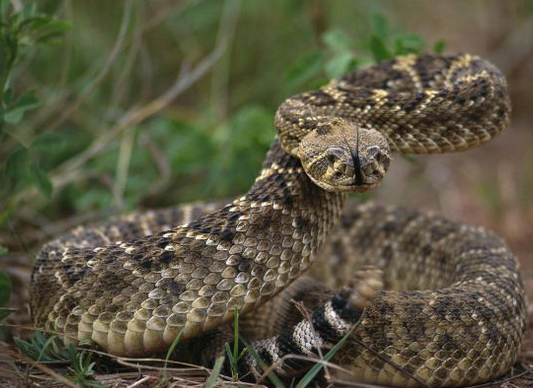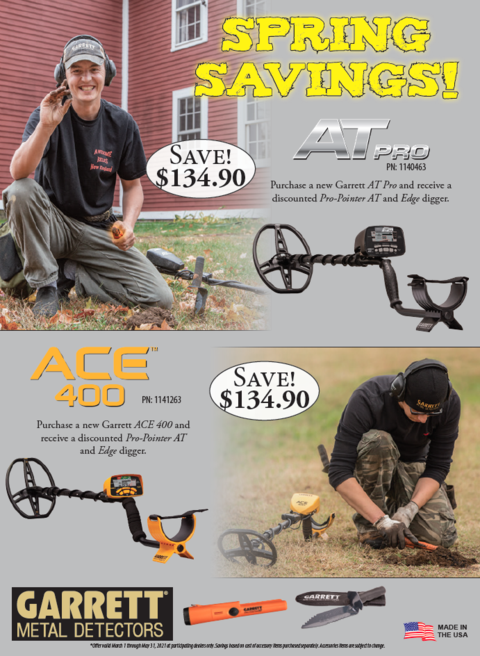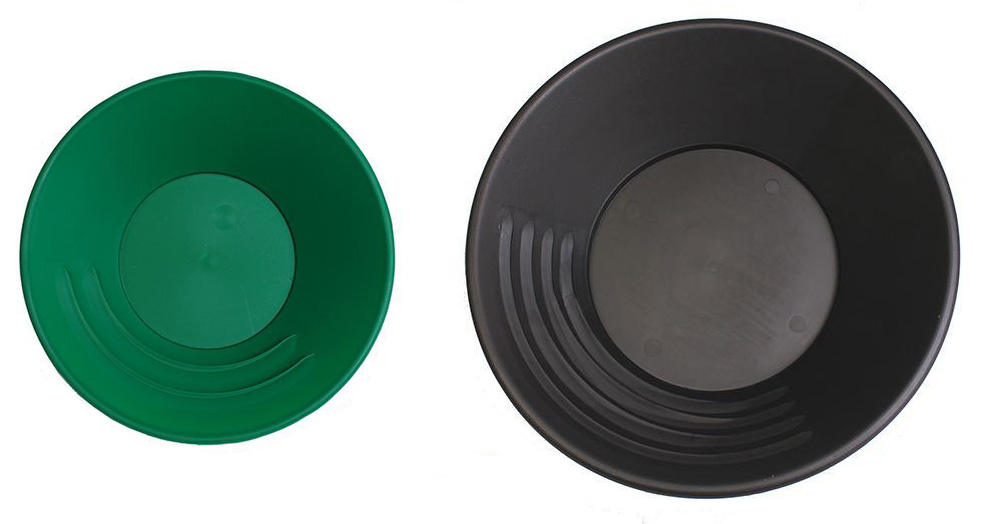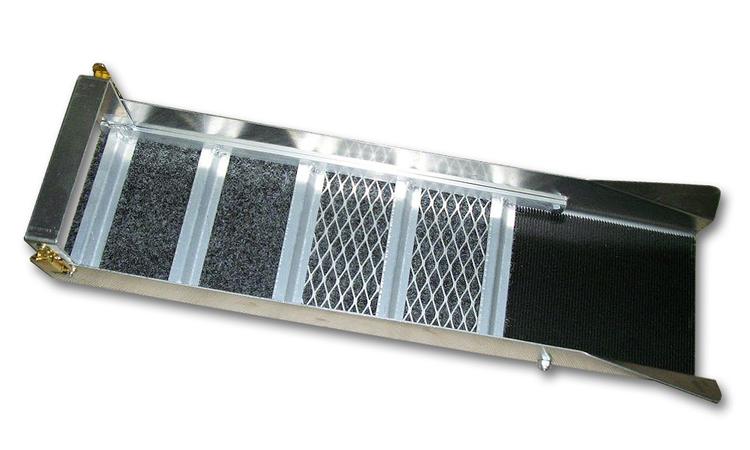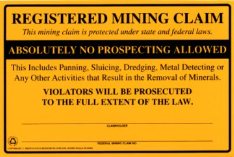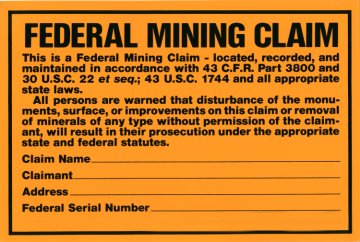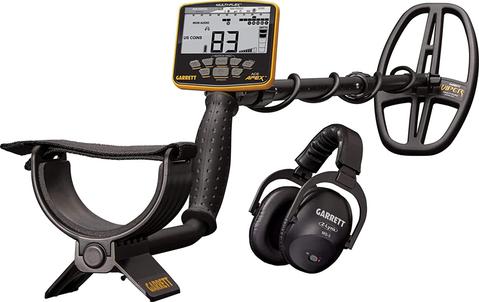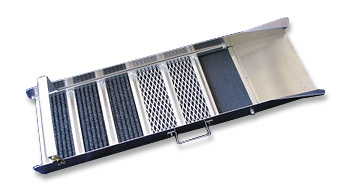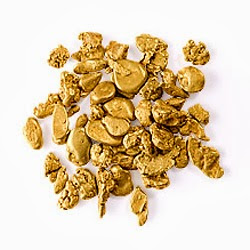Sunday, April 25 2021
Depending on where you live, spring is in the air, either a little or a lot. What that mostly means is we're all getting out and about more to prospect for gold, metal detect, and just clean up around our property. Especially as restrictions from Covid-19 are lifted, we’re hankering to get out and have fun. In general, springtime ushers in rain, warmer Snakes love warmer days. As reptiles, their body temperature mirrors air temperature, so it’s common to begin seeing many more snakes this time of year. And that means spring is also a good time to be extra vigilant about where you step and sit. Most rattlesnake bites occur when you accidentally step on or near a snake and startle it. That’s easy to do when you’re zoning out swinging a detector or hiking in tall grass toward your favorite gold-bearing river. When you are otherwise distracted by gold fever or a chore (stacking wood, cleaning out your shed, landscaping), you might not be thinking about where you’re putting your hands and feet.
• Call 911 immediately or get yourself to a hospital as quickly as possible. As you venture outside this spring and summer, help protect your lower legs with snake gaiters— they also help protect against thorns, briars, and cacti needles. If you've ever brushed against them by accident, you know how painful that can be! Snake leggings are used by the US Border Patrol, US Forestry Service, hunters, hikers, fishermen, ranchers, surveyors, realtors, landscapers, and thousands of treasure hunters who need protection for lower legs. Don’t take a chance! Take precautions to be safe this season— whether in the desert or woods — by adding snake gaiters to your list of “must have” equipment. Monday, March 15 2021
Spring is in the air, and Garrett is making it a little easier on your wallet to get out there and start swinging a new metal detector! For a limited time, Garrett is offering two specially-priced packages. Each package includes a metal detector, headphones, an AT Pinpointer, and Garrett Edge Digger. You save $134.90 on a package as compared to buying each component separately. Both packages have FREE SHIPPING, too! Garrett AT Pro Metal Detector and Headphones. The AT Pro is Garrett's all-terrain, all-treasure, deep-seeking, professional treasure hunter's detector! This all-terrain detector offers new and exclusive Garrett technology that makes highly recommended for Coin Hunting, Jewelry Hunting, Relic Hunting, Cache Hunting, Prospecting, Ghost Town Hunting, Competition Events, Beach/Fresh Water Hunting. Select from either Standard or Professional search modes with enhanced audio features. The AT Pro was designed to work in challenging environments such as mineralized ground, high trash areas, wet and humid areas and dust. In fact, the entire metal detector can be submerged under water to a dept of 10 feet, so it's an excellent choice for detectorists who might also be gold prospectors working in streams, ponds, or shallow water off the shoreline. Includes upgraded MS-2 headphones, Pro-Pointer AT Pinpointer and Garrett Edge Digger. Details on AT Pro Spring 2021 package here. Garrett ACE 400 Metal Detector and Headphones. The top of the ACE family, the 400 has a new Iron Audio feature, a powerful DD coil, a higher frequency, and volume control headphones. Its advanced features make the ACE 400 powerful on coins, jewelry, and artifacts. Features a 8.5” x 11” PROformance DD submersible searchcoil. Comes with Pro-Pointer AT Pinpointer, Garrett Edge Digger, and ClearSound Easy Stow Headphones that feature padded ear pieces, 41 inch coiled cord extends to 82 inches, and 1/4 inch phone plug. Details on ACE 400 Spring 2021 package here. Metal Detectorist Code of Ethics
Sunday, March 07 2021
Raw TV in London is the maker of the Discovery Channel's hit TV series Gold Rush. You might also have watched a spin-off, Dave Turin's Lost Mines. Dave is looking to hire a geologist with placer /hard rock mining experience to join his mining crew on that Discovery show. Ideally, the candidate will have specialized in gold mining and have experience working with placer and/or hard rock deposits. Applicants must be over 18, eligible to work in the US, and happy to appear in a new season of Dave Turin’s Lost Mine. You must be willing and able to leave home and join his gold mining crew potentially from May - October 2021. If you are a geologist who would love to be considered for this role, or know someone, visit this link https://www.raw.co.uk/takepart/geologist-miners-wanted Closing date to apply is April 15, 2021.
Monday, March 01 2021
A gold pan is the simplest and most basic prospecting tool and is one of the oldest types of gold concentrating equipment. Plastic pans are recommended over the steel pans used by the 49ers. Plastic is light weight, so when you add water, dirt, and gravel to your pan, your arms won't get as tired compared to using a steel pan. And they do not rust or conflict with the use of a magnet. Size, color, and shape are really a matter of personal preference. You might want to have a couple different sizes of gold pans on hand (10 inch, 12 inch, and 14 inch are the most popular). Plastic pans generally come in green, black, and blue. The color doesn't effect performance, but green is the most common. The bright blue cone-shaped batea is the newest type of gold pan to hit the U.S. market. Gold panning kits are often the most economical way to purchase gold pans and classifiers (often called sifting pans) and other small accessories all in one convenient box. The point of panning is to shake the gravels, allowing the gold to settle downward and then to wash the lighter material off the top. When all the lighter material has been removed, only the heavy concentrates will remain in the bottom of the pan, including, hopefully, some gold! With a little practice, anyone can learn to pan for gold. Buying a bag of gold-bearing paydirt to use over and over again for practice in a tub is one way to get good at panning without ever leaving home. Gold panning “how to” steps founds here.
Gold concentrations are spotty, even in known gold-bearing areas, so sample and test often. Be sure to move on with your gold pan and don’t stay in one spot less you have good results. If you find a spot with fairly large amounts of gravel that yields good gold, then it’s time to bring in a sluice box. A sluice is simple to operate and have been used all across the world for thousands of years. After you’ve mastered gold panning and are ready to increase the amount of gravel you can process, a sluice box is your next step up from hand panning. Sluices come in a variety of sizes, most with gold-catching matting in the bottom that you need to clean up at the end of the day. Other models such as the Gold Well Vortex Drop Riffle Sluice, has no matting or carpets and uses vortex technology to catch fine gold.
As with the pan, the real secret of successful prospecting is not in operating the equipment, but in the skill of finding those natural gold catches. Learning to read the river or stream and recognize the places where gold might accumulate and then sampling those places to see if you are correct is the best technique. Inside bends, behind boulders or bedrock outcrops, and inches above the stream flow are all good places that you might sample, but there are plenty of other possibilities as well. The sluice and the gold pan may be among the most basic prospecting tools, but they are tried and true ways of finding some good gold! Friday, February 19 2021
There are many interesting facts about the element gold, which is listed on the periodic table as Au. Au—comes from the old Latin A few more fun and fascinating facts about gold include:
Monday, January 18 2021
As of 2020, there were about 3,891,000 mining claims filed on federal lands across open-for-mineral-entry states. If you want to join the ranks, the following will be extremely helpful. This information was published in November 2020 by Kevin Hoagland, Executive Director of Development, Gold Prospectors Association of America (GPAA). A mining claim is a selected parcel of Federal land, valuable for a specific mineral deposit(s), for which you have asserted a right of possession under the General Mining Law. Your right to the claim is for the extraction of those minerals. The rights granted by a mining claim protect against a challenge by the United States and other claimants— but only after the discovery of a valuable mineral deposit. Your claim is not protected from the government or other miners until you have a discovery of a valuable mineral, recorded in the county of location, and have filed a mining claim with the Bureau of Land Management (BLM). There are two types of mining claims—lode and placer. In addition, mill sites and tunnel sites may be located to provide support facilities for load and placer mining claims. Once all the steps— locate, record and file— are properly completed, then you have rights to the minerals only on the claim. You cannot live on a claim unless you have a Plan of Operations (POO) that includes project occupancy, and that will allow only limited occupancy during the duration of the project and is most likely going to be added into the required bond of the project within the POO and the Notice of Intent (NOI). If you do not have an occupancy, then you are required to follow the stay limits of 14 days in any given 28-day period. You cannot keep other people off your claim with the exception of people trying or working to recover the valuable minerals that are on your claim. This is clearly defined as mineral trespass and is enforceable. However, if people want to use your claim for day-use recreation, or for camping or hunting at various times of the year, you cannot legally not allow them ingress to your claim unless you have an in-place POO that designates a mining area and other areas that support your efforts to recover valuable minerals. The BLM will work with a POO holder to include as much of the claim as possible to keep ingress limited for safety. Who Can File a Mining Claim? A person who is a citizen of the USA or has declared an intention to become a citizen with the Immigration and Naturalization Service may locate and hold a mining claim or site. A corporation organized under state law is considered a citizen and may locate and hold a mining claim or site. A corporation is held to the same standards as a citizen. There is no limit to the number of claims and sites that you may hold as a qualified claimant, as long as you meet the General Mining Law requirements of the claims filed after a valuable mineral find has been located. Where Can You File a Mining Claim? As of this writing, there are 19 states where you may locate mining claims or sites: Alabama, Alaska, Arizona, Arkansas, California, Colorado, Florida, Idaho, Mississippi, Montana, Nebraska, Nevada, New Mexico, North Dakota, Oregon, South Dakota, Utah, Washington, and Wyoming. Who Maintains All of This? The BLM manages the surface of public lands in these states and the Forest Service manages the surface of National Forest System lands. The BLM is responsible for the subsurface minerals on both its public lands and National Forest System lands. You may prospect and locate mining claims and sites only on lands open to mineral entry. Some recreational areas are open to the public for casual prospecting (usually just for gold panning by hand); these areas would not be considered open to mineral entry, therefore, you cannot file a claim in certain recreational areas. How to File a Mining Claim To file a claim, you need to start by prospecting to find a valuable recoverable metal. There are a number of ways to get started in finding an area open for claiming. Using computer programs such as the BLM LR2000, you can get a much better view of what is and is not open for claiming. After you have prospected and found gold or other mineral you wish to extract, you will want to stake a claim. Using your GPS or a topo map and compass, figure out exactly where you are. Set your Point of Discovery (POD), then find your corners. A placer claim is 20 acres— a rectangle that is 660 feet from west to east, and 1,320 feet from north to south. Situate your claim as close to the topo section lines as possible and create your location notice and draw your map. The map must include the township (an area of 36 miles), the range (the area either east or west of the principle meridian, which is on the bottom of each topo map), and section (each section is 1 square mile; 36 sections make up a township). Within the section there are quarters and halves that are broken down to the smallest part, which is 20 acres. TIP: Walk the entire claim and make small rock cairns at each of the corners based on GPS to find the spots more easily when you come back to mark the corners. Knowing how far it is from the POD to the NW corner and SE corner is also helpful. You will need that info. when recording and filing your claim. Once recorded, take your recorded document to the BLM office closest to you that accepts filings. Present your county-recorded documents and your map. The BLM will quickly review your paperwork, assign a Mining Claim (MC) number, take your money and hand you back copies of your docs with the MC number for your records and to post on the claim. Ask both the county and the BLM what is acceptable for your markers and what is required. In some states, all that is required is the POD and not corners. But your MC paperwork at the POD MUST have the distance from the POD to a corner or distance to a Public Lands Survey (PLS) Marker. You have now recorded and filed and have an approved mining claim. Set your corners and markers and you’re done! Mining Claim Signs found here. CONGRATULATIONS and good luck getting the GOLD! Sunday, December 20 2020
There is truly no single “best” type of detector when it comes to gold hunting. But understanding the differences between a VLF (very low frequency) and a PI (pulse induction) detector and their coils can help you decide which detector might be the “best” to use in a A VLF machine can have an advantage on shallow and very small targets, on and off of bedrock— as long as you can keep it stabilized, ground balanced, and the sensitivity set properly. PI detectors generally do better at greater depths than VLF machines, especially in highly mineralized soils. Mono coils are designed for PI detectors. There is a single winding inside the coil that puts a concentric pattern into the ground. You will always get more depth with a mono coil, but it is more susceptible to ground mineralization noise and it will be affected by the ground mineralization itself. Double D coils work for both PI and VLF detectors. Double D coils have two back-to-back D shaped windings inside the coil. At all times the coils are transmitting and receiving across the plane of the coil. The Double D design is like a knife blade that goes into the ground down the center of the coil. These coils are great at handling mineralization where it essentially takes the ground mineralization and distributes it all the way across the blade, lessening its effects. Concentric coils work with VLF detectors by using two separate windings inside the coil— one sends and one receives. When it comes to a round versus elliptical coil, there is really no difference in the size, only shape. Coils are measured off of a round coil configuration. For example, a 14 x 10 inch coil will have the same attributes as a 12-inch coil. The key difference is that elliptical shapes work extremely well in difficult areas. Although each metal detector has its pros and cons, you can’t go wrong by wearing the best headphones possible, no matter which brand or model you choose. Many gold nuggets you will find are only slight whispers in the detector’s threshold, so you want to always wear high quality headphones. Plastic scoops and a digging tool with a wide blade should also be in your accessory bag. When hunting, limit the amount of metal on your body, which includes wearing non-magnetic boots and belts. Put your car keys in your back pocket. Keep your cell phone in your back pocket, too, and make sure it’s off to avoid any interference. Saturday, December 05 2020
With gold prices on the rise, you might be wondering if now is a good time to sell some of the gold you’ve found over the years. And if Gold dust consists of flour, fines and flakes. This is the stuff most prospectors find as a result of panning, sluicing and dredging. This form of gold is probably the lowest value because it will have the most impurities. Small nuggets start at about 1 gram and are a step up from gold dust in value. Medium nuggets, on average, weigh up to 31 grams or 1 troy ounce. Large nuggets are defined as weighing 1 troy ounce or more. Larger nuggets usually command higher prices, and could be considered museum quality. Gold in quartz is usually a collector’s item or a museum piece, therefore, prices widely vary. Keep in mind, though, that even nuggets that appear to be pure gold are not. They will have impurities embedded and blended into the matrix. There is no such thing as 100% pure gold from nature. In fact, in North America, the average purity for prospected and mined gold averages 60% - 85%. The impurities in natural gold consist of metals such as silver and copper and other minerals that have combined with gold on a molecular level. Tests, referred to as an “assay” must be performed to accurately measure the purity of gold. Some jewelers and pawn shops can analyze your gold to determine purity with an XRF gun (X-Ray Fluorescence); expect to pay a charge for that service. The majority of gold bought and sold from small-scale prospectors include: private buyers (some advertise on eBay, Craigslist, and other online sites) pawn shops, independently owned jewelry stores that craft and repair their own jewelry, museums looking for unusual specimens or rare nuggets, and refiners. Most refiners are contracted by large gold mining operations, but some smaller refiners will purchase gold from prospectors in any form or mesh size. An internet search will reveal refiners that will buy from individuals. If you want to sell your fine gold or nuggets, there are a few things to do first. You may not get a totally accurate assessment of your gold’s value, but you’ll at least have a ballpark estimate. Do NOT melt your gold. Keep it in its original form.
When you make contact with potential buyers who specialize in raw and natural gold, be sure to ask about and understand their procedures and policies and payments. Ask how your gold will be assayed and how the purity is determined. If you are shipping your gold to a buyer, understand their requirements for packaging and shipping, insurance, and other safeguards. Some buyers pay for the testing and shipping, others pass along the costs to the seller. Remember that buyers have costs and will not pay 100% of the spot price. The exception to this would be if you have museum specimens or very large nuggets. In those instances, buyers will pay more than the spot price. Be patient and shop around to not only get the best price, but to find a buyer who you can work with now and in the future. Get recommendations from fellow prospectors, or clubs such as GPAA (Gold Prospectors Association of America). If possible, make your first transaction with a new buyer a small one to assess your experience and satisfaction with the overall sales process. When you feel you have had a successful first transaction, you’ll feel confident you can continue that relationship in the future. If you've not yet found your first gold, get Alaska paydirt here. Monday, November 16 2020
The use of water for grinding and milling has been in practice for thousands of years. From simple water wheels to inventors such as Water Flow. The easiest example of how water dynamics affect gold is the classic inside bend in a waterway. When stream flow is straight and velocities are at their highest, gold will be suspended in the flow. As a bend in the stream causes flow to begin slowing down, the heaviest gold begins to drop out because the water no longer has enough velocity to suspend the material. The stream continues to lose power as the bend length increases and smaller and smaller gold continues to be deposited until there is no longer any in suspension, or the remaining water flow and speed cannot carry it farther downstream. Water velocity and flow affect attempts at recovery in all capture devices in exactly the same way. Each piece of gold in classified material requires a certain flow and length of time to separate, drop out, and be captured based solely on its relative size and weight. If the velocity and flow are too great, the gold will remain suspended and will exit the machine regardless of machine length or method of recovery. This is why some miners are lured into a false sense of security just by using longer sluices. Improper water depth in the sluice can create additional problems in recovery. Methods of material collection have much less effect if the gold is suspended in the upper part of the water flow. Most sluices provide little or no material agitation to break up the classified material and provide the necessary change in flow that facilitates gold separation. Lack of agitation allows smaller pieces to be carried through the equipment. Classification. There is a direct relationship between material classification and water speed, which is often overlooked. It is common to classify for ease and speed of filling buckets rather than size of gold being targeted. Larger classification requires increased water speed to push the material through most recovery systems. The trade-off is forfeiting recovery of finer gold by increasing the length of drop time. This reduces the number of gold capture attempts and even machine effectiveness by having concentrations of larger material wedging into riffles, drops, etc. Running dry material requires the sluice to liquefy the material while it is passing through. Gold particles will suspend in the dry material, reducing the chance of capture. Many miners use a scoop and drop their material into the machine in large clumps. This also allows particles to suspend instead of being processed. Material should always be wet prior to processing, and material should be cast (sprinkled) side to side across the machine when using a scoop. Riffles. Some riffle designs are actually not that ideal for gold recovery. Some sluice riffles are evenly spaced, making them too far apart to impart the “vortex” or reverse underflow. What actually happens is an up-and-down wave motion as the water travels down the sluice. The only “action” imparted is the same negative flow that happens when water flows over a rock or some other obstacle in a stream. Material suspended at the bottom of the flow is deposited as the water climbs over the riffle and slows. Material that is heavy enough and can no longer be suspended drops. The rest of the material remains in the flow and continues to be carried down (and possibly out of) the sluice. Flare. Most modern riffle sluices (standard and drop designs) are susceptible to improper setup angle, which can either clog the machine with material or blow it out completely. Either problem results in the loss of gold. Another big mistake in sluice design and operation is the “V” fallacy. The idea that channeling your water towards the center of the sluice using a wide-angle flare will increase its effectiveness and therefore increase gold recovery is false. On top of that, miners drop material into the center of the slick plate. This forces material into the center of the sluice, which is quickly overloaded by the volume of material and will cause the first series of riffles to lose their effectiveness. Remove the flare from your sluice to eliminate the center concentration and create an even flow across the machine. You can create a V-shaped wing dam with a short straight section in front of your sluice if you need increased water flow or speed. Casting your material across the width of the sluice will eliminate overloading of the riffles. Understanding how water height and speed changes your recovery can also make all the difference in boosting gold returns: Water height. Begin with the water flowing just above the riffles or drops. Run small amounts of material and watch as the dirt passes through the sluice. Notice how the material enters the riffles or droops. Be sure to use the correct method of casting material evenly from side to side. Gradually increase the water height until processing suffers. This will determine the minimum and maximum water height for your sluice or highbanker. Water velocity (speed). Set your sluice water height for max processing and a fairly fast flow, then gradually reduce water speed as you process small amounts of material. You may have to adjust your sluice to maintain proper water height through this process. Note how changes in water speed decrease the quality of material processing. Spend some time exploring water dynamics. Introduce only one variable at a time, and verify how your gold recovery is affected before moving on. No doubt, with a little more understanding and experimentation, you’ll recover more gold with your sluice! Monday, October 19 2020
Are you excited about finding gold — ANY size gold? Most of us are, but if you want to sound like an old pro when referring to a Flour Gold: Gold particles that are barely visible to the naked eye. It’s so powdery, like flour, that it sometimes floats instead of sinks like heavier gold pieces. Flake Gold: A piece of gold that is large enough to easily spot, but is difficult to pick up with your fingers. Use tweezers. Fines: Particles of gold too small to pick up with your fingers. Combination of flake and flour gold. Picker: A piece of visible gold large enough to easily pick up with your fingers. Gold Nugget: Larger than a picker. A naturally formed lump of gold that is big enough to put in a poke and likely won't fit in a typical small vial, depending on its shape. Specimen: A naturally formed large gold nugget or gold-laced quartz specimen. Paydirt: Refers to dirt that has enough gold in it to be worth extracting. The term originated in the mid-1800 during the California Gold Rush. Today, you can even buy Alaska paydirt through the US Mail! Concentrates: All the gold-bearing material left in your sluice or trommel, etc. after using your gold recovery equipment - usually black sand mixed with fine gold. Fool’s Gold: The bane of any prospector’s existence! Iron or copper pyrites and mica can be mistaken for gold. The quickest and simplest test is to examine your sample in the shade, not in the sunlight. Real gold retains its yellow sheen even in shadow, whereas fool's gold does not. Real gold is soft and malleable; it can be cut with a knife and won't splinter. You can even "dent" it with a pin. Fool's gold, though, is hard and flaky. A drop of hydrochloric (muriatic) acid will tell you for sure. Real gold will not be affected, but if you see a slight foaming action and the sample begins to dissolve, you know it's not real gold. Color: Slang for any amount or size of visible gold that you find in your gold pan. Au: Gold is element 79 and its symbol is Au on the periodic table. As a pure metal, gold is extremely heavy with a specific gravity of 19.3, which means pure gold weighs 19 times more than an equal amount of water.
|
|
Nugget of News Blog |






